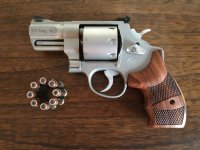divotmaker
Member
- Joined
- Apr 26, 2014
- Messages
- 9
- Reaction score
- 2
I have a 351 pd with a gunsmith trigger job that improved the DA pull and so far with approximately 500 rounds no bad primer strikes or issues. This post is not a discussion of the well known Smith advice not to change springs, etc.
I purchased a 351c hammerless because my experience with the 351pd convinced me this little 7 shot revolver would be a good summer and pocket around the house carry option, without the risk of the hammer. I have 100 rounds through it so far.
I knew the trigger pull would be strong, and I can handle it, but accuracy clearly suffers a bit. It seems that reading about the 351c, trigger jobs can be even more problematic than with the hammer version 351 pd. Thus before I take this to the gunsmith for a trigger job, I would love to hear from any of you that have actually put a good number of rounds through your hammerless model. Has your trigger pull really gotten any better with increasing round count like with many larger caliber revolvers, or are the heavy springs used in these revolvers relatively refractory to improvement with routine use?
I purchased a 351c hammerless because my experience with the 351pd convinced me this little 7 shot revolver would be a good summer and pocket around the house carry option, without the risk of the hammer. I have 100 rounds through it so far.
I knew the trigger pull would be strong, and I can handle it, but accuracy clearly suffers a bit. It seems that reading about the 351c, trigger jobs can be even more problematic than with the hammer version 351 pd. Thus before I take this to the gunsmith for a trigger job, I would love to hear from any of you that have actually put a good number of rounds through your hammerless model. Has your trigger pull really gotten any better with increasing round count like with many larger caliber revolvers, or are the heavy springs used in these revolvers relatively refractory to improvement with routine use?

